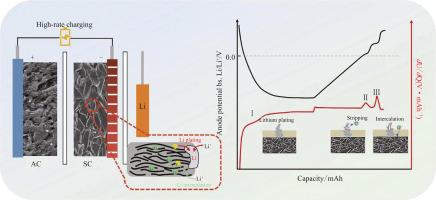Lithium plating accurate detection of lithium-ion capacitors upon high-rate charging
IF 16.4
引用次数: 0
Abstract
Lithium-ion capacitors (LICs) offer higher power density and longer cycle life compared to lithium-ion batteries, and greater energy density than supercapacitors, making them ideal for applications requiring both high energy and power density. However, during high-rate charging, LIC anodes may suffer from lithium plating, a critical issue that remains unaddressed. To date, no direct analytical technique exists to study lithium plating behavior on LIC anodes. This study is the first to employ a 3-electrode pouch-type LICs, using differential analysis of the anode potential rather than the traditional terminal voltage approach, to accurately detect the charging rates at which lithium plating begins. We employed differential charging voltage (DCV), Coulombic efficiency (CE), and voltage relaxation profile (VRP) methods to comprehensively analyze lithium plating behavior. The feasibility of indirectly detecting lithium plating was validated by applying the CE and VRP methods to high-capacity 1,100 F LICs. The study found that lithium plating in LICs begins at a charging current of 20 C. The lithium deposited at currents below 50 C is reversible, while at currents above 50 C, irreversible dead lithium is formed. Furthermore, the study identified two reverse reactions following lithium deposition on the anode: lithium stripping and lithium intercalation. For soft carbon anodes, the potential difference between lithium stripping and intercalation was approximately 20 mV under relaxation conditions, and about 45 mV under constant voltage conditions. This research provides critical theoretical insights and practical guidance for optimizing LIC charging strategies.

镀锂高倍率充电时锂离子电容器的精确检测
与锂离子电池相比,锂离子电容器(lic)具有更高的功率密度和更长的循环寿命,并且比超级电容器具有更高的能量密度,使其成为需要高能量和功率密度的应用的理想选择。然而,在高速充电过程中,LIC阳极可能会受到锂电镀的影响,这是一个尚未解决的关键问题。到目前为止,还没有直接的分析技术来研究锂在LIC阳极上的镀锂行为。这项研究首次采用了3电极袋式锂离子电池,使用阳极电位的差分分析而不是传统的终端电压方法,来准确检测锂电镀开始时的充电速率。采用差分充电电压(DCV)、库仑效率(CE)和电压弛豫曲线(VRP)方法综合分析了锂电镀行为。将CE和VRP方法应用于大容量1100f锂离子电池,验证了间接检测镀锂的可行性。研究发现,锂离子电池的锂电镀始于20℃的充电电流,在50℃以下的电流下沉积的锂是可逆的,而在50℃以上的电流下,形成不可逆的死锂。此外,该研究还发现了锂在阳极沉积后的两种逆反应:锂剥离和锂嵌入。对于软碳阳极,弛豫条件下锂剥离和插层的电位差约为20 mV,恒压条件下约为45 mV。本研究为优化LIC充电策略提供了重要的理论见解和实践指导。
本文章由计算机程序翻译,如有差异,请以英文原文为准。
求助全文
约1分钟内获得全文
求助全文

 求助内容:
求助内容: 应助结果提醒方式:
应助结果提醒方式:


